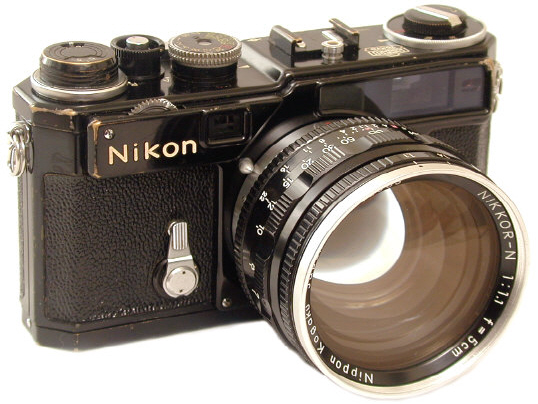
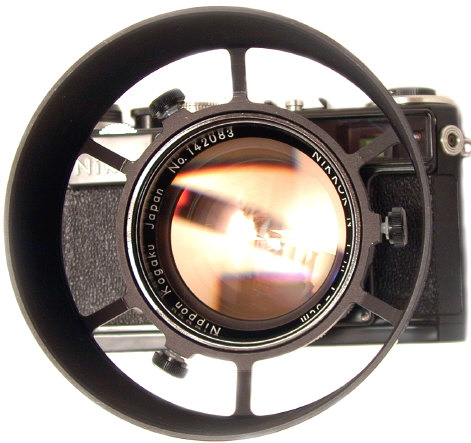
CameraQuest Home Shopping Cart Price List Camera Articles I Buy / Wants Repairs Books Adapters


This is my own favorite collector's lens of all time. From an esthetic viewpoint, it is simply a very huge, beautiful and impressive lens. It was made in three versions: the original internal Nikon mount, the external Nikon mount, and it was also made in Leica screw mount.
The internal mount fits on the body like the regular 50 mm lenses, into the inside bayonet. The mount was not strong enough to take the excessive weight. Introduced while the Nikon S2 was in production, the 1.1 internals went back to the factory to have the mount precisely adjusted for the 1.1's extremely limited depth of focus. The weight of the 1.1 internal can bend the front mount or strain the focusing wheel mechanism. Another problem area are the "fingers" on the rear mount which can break off.
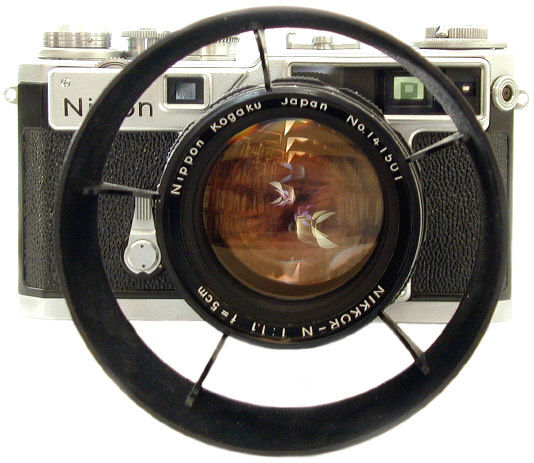
Note the immense size of the hood, and the 3 light reflections within the finder. A new improved 50mm f/1.1 hood was introduced in March 2003 by Tom Abrahamsson.
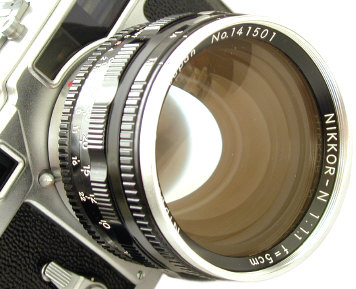
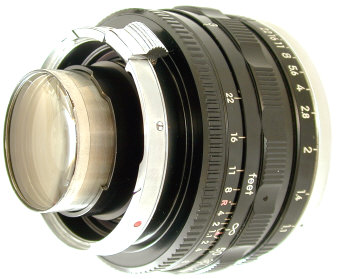
The external mount 50mm f/1.1 shown here fits on the external bayonet, like the telephotos and wide angles and did not need each body adjusted for it. The external version is more popular with collectors, and commands a higher price than the internal version. DO NOT try to focus these lenses with the focusing wheel-- the camera's focusing wheel mechanism is simply not strong enough to handle the weight of the big 1.1. Instead use the external's helical focusing, or use the internal mount's barrel. Like most Nikon rangefinder lenses, turn the lens and the body helical to infinity before mounting or dismounting lenses.
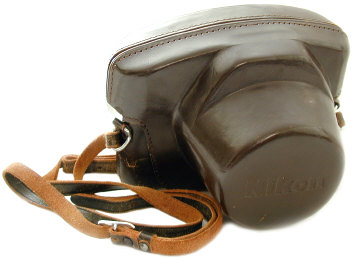
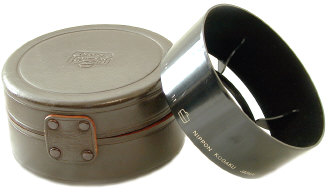
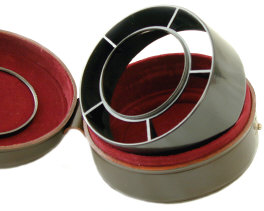
The SP 50mm f/1.1 ever ready case is quite rare. Most self destructed with old age. The flap connection from the top to the bottom of the case, and the straps themselves, are the points most likely to break.
The huge lens shade came with its own special case, inside of which was a 62mm Nikkor UV filter.
Being so large, these lenses have two problem areas. It's not unusual to find 1.1's with separated lens elements, or more often, with damaged diaphragm blades. Either of these repairs requires a true expert repairman. Turn the aperture blades SLOWLY. Turning them quickly will eventually result in an expensive repair. Other than dropping their prized Nikon on concrete, about the saddest look of a Nikon Rangefinder collector is after they destroy their 50mm f/1.1 aperture blades by seeing how fast they can open and close the blades.
As large as the lens is, the special lens hood is MUCH bigger, probably the largest lens hood ever made for 50mm lenses. Two versions were made, plastic and metal. The plastic version is more numerous than the metal, and is easily broken. Very few 50mm f/1.1 hoods of either type have survived the years. I've been told unbroken plastic 1.1 shades often sells for more than the metal version in Japan, because there are fewer plastic shades which have not been broken.
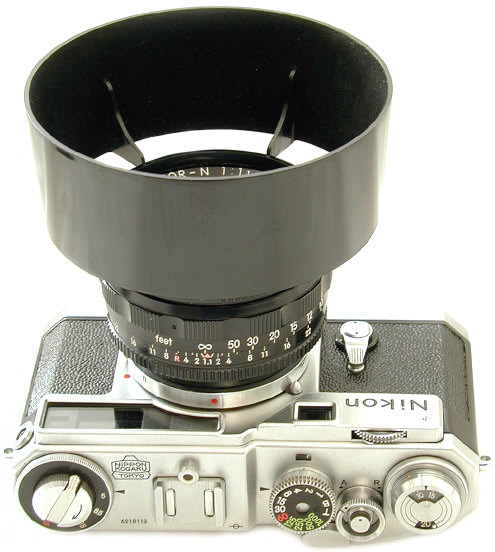
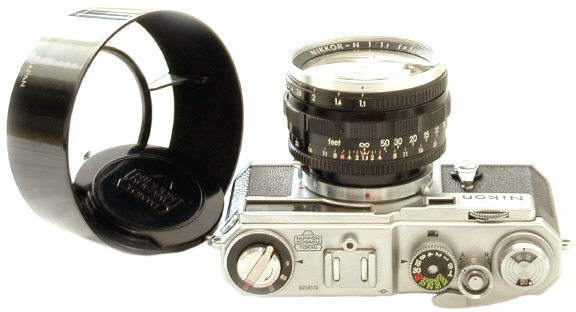
In the late 50's camera manufacturers were having a "Speed" race to develop the fastest lenses. As impressive as the 1.1 was, wide open was not much to write home about. Good for the time, but certainly not competitive with modern optics. The rare 1.1 is a collector's lens, not a user. Both mounts, but especially the external, are very popular and sought after by collectors. The large and easily broken 62mm Nippon Kogaku lens cap is sitting inside the lens shade.
The 1.1 in Leica mount is the rarest and very seldom seen. The demand amongst collectors, however, is much lower for Nikkor lenses in Leica screw mount than Nikkor lenses in Nikon mount. As a result, the rarer Leica mount sells for about the same as the external. All 3 versions take the same front cap and shades.
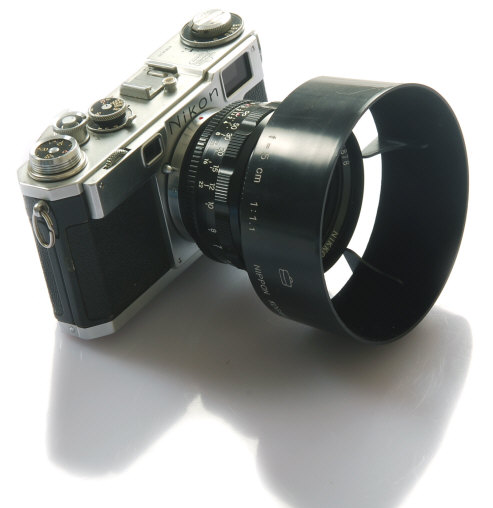
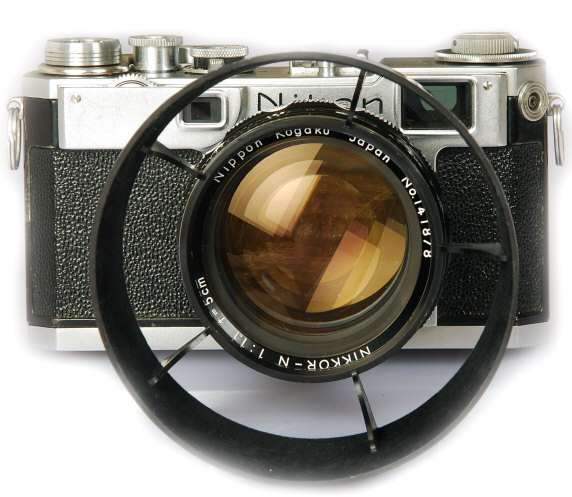
Black Dial Nikon S2 with external mount 50mm f/1.1 Nikkor and shade
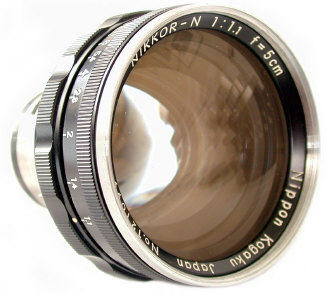
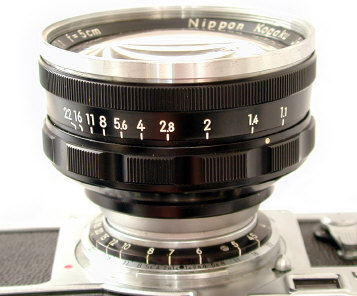
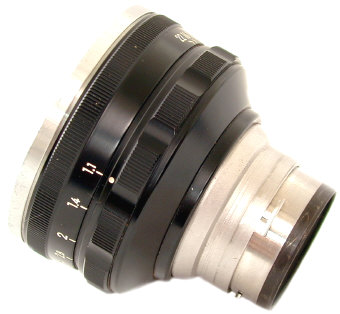
side by side, internal mount 1.1 and external mount 1.1
The 50mm f/1.1 internal mount uses the internal bayonet mount and camera's focusing helical, like the smaller 50/1.4, 50/1.5, 50/2, and 50/3.5 lenses. Visible on the right are two of the three "fingers" on the rear mount. If the fingers are broken off, I know of no way to make a satisfactory repair. The internal mount 1.1 was replaced by the external mount after Nikon realized the camera's helical and focusing wheel mechanism could not handle the strain of the big 1.1's weight. The best way to focus the internal mount 50mm f/1.1 is to turn the lens barrel, NOT the focusing wheel.
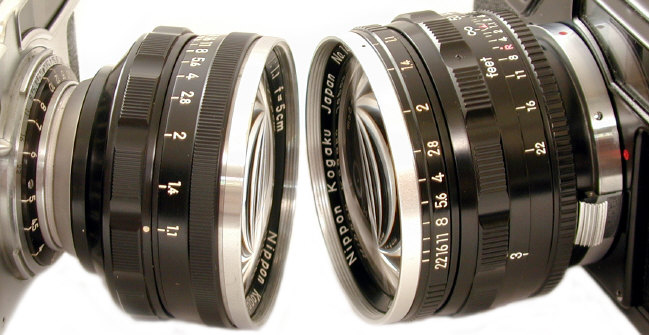
Fast Times with Fast Rangefinder Lenses


Left to Right: Canon 50/.95 for Canon 7/7s, Leitz Noctilux 50/1 Leica M mount, Voigtlander 50mm f/1.1 Leica M mount, 50mm f/1.1 Nikkor Leica Screw Mount, 50mm f/1.1 Zunow Contax rangefinder mount
Voigtlander Nikon/Contax Rangefinder Related Products
Voigtlander Bessa R2S R2C Rangefinders in Classic Nikon or Contax Rangefinder Mounts
Voigtlander Bessa R2S 50/3.5 Heliar S NHS Commemorative in Classic Nikon Rangefinder Mount
Voigtlander SL 12/5.6 and 15/4.5 Aspherical widest EVER for NRF
Voigtlander Nikon Rangefinder SC Mount Lens Intro 21/4, 25/4, 35/2.5 intro
Voigtlander Nikon Rangefinder SC Lenses: SC 21/4, SC 25/4, SC 28/3.5, SC 35/2.5, SC 35/1.2 Prototype, S 50/1.5, S 50/2.5, S 50/3.5, S 85/3.5
Voigtlander VC Meter II small compact silicon meter with LED readout for Nikon Rangefinders
CameraQuest Home Shopping Cart Price List Camera Articles I Buy / Wants Repairs Books Adapters
Revised: September 12, 2017 . Copyright � 1998-2009 Stephen Gandy. All rights reserved. This means you may NOT copy and re-use the text or the pictures in ANY other internet or printed publication of ANY kind. Information in this document is subject to change without notice. Other products and companies referred to herein are trademarks or registered trademarks of their respective companies or mark holders.